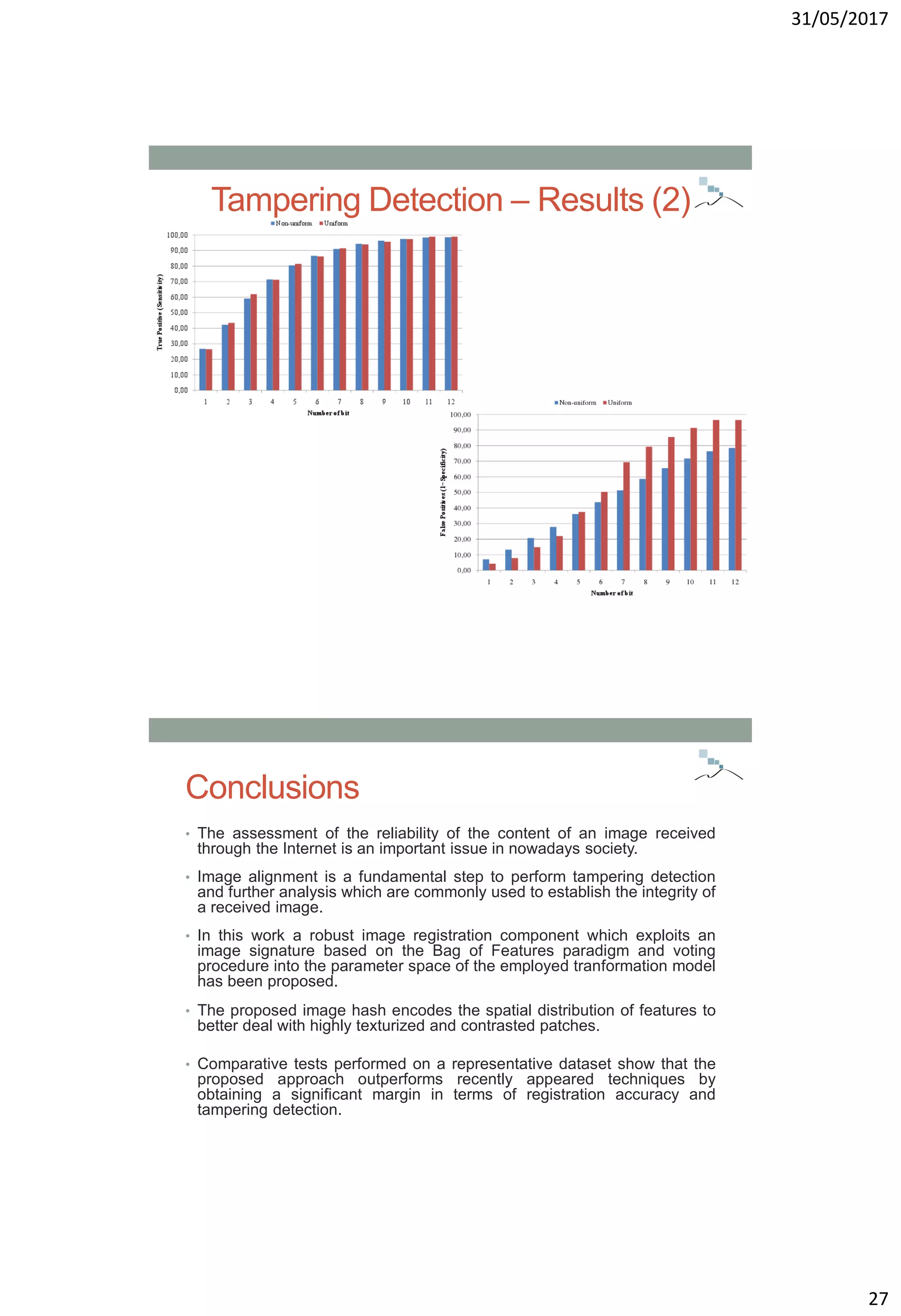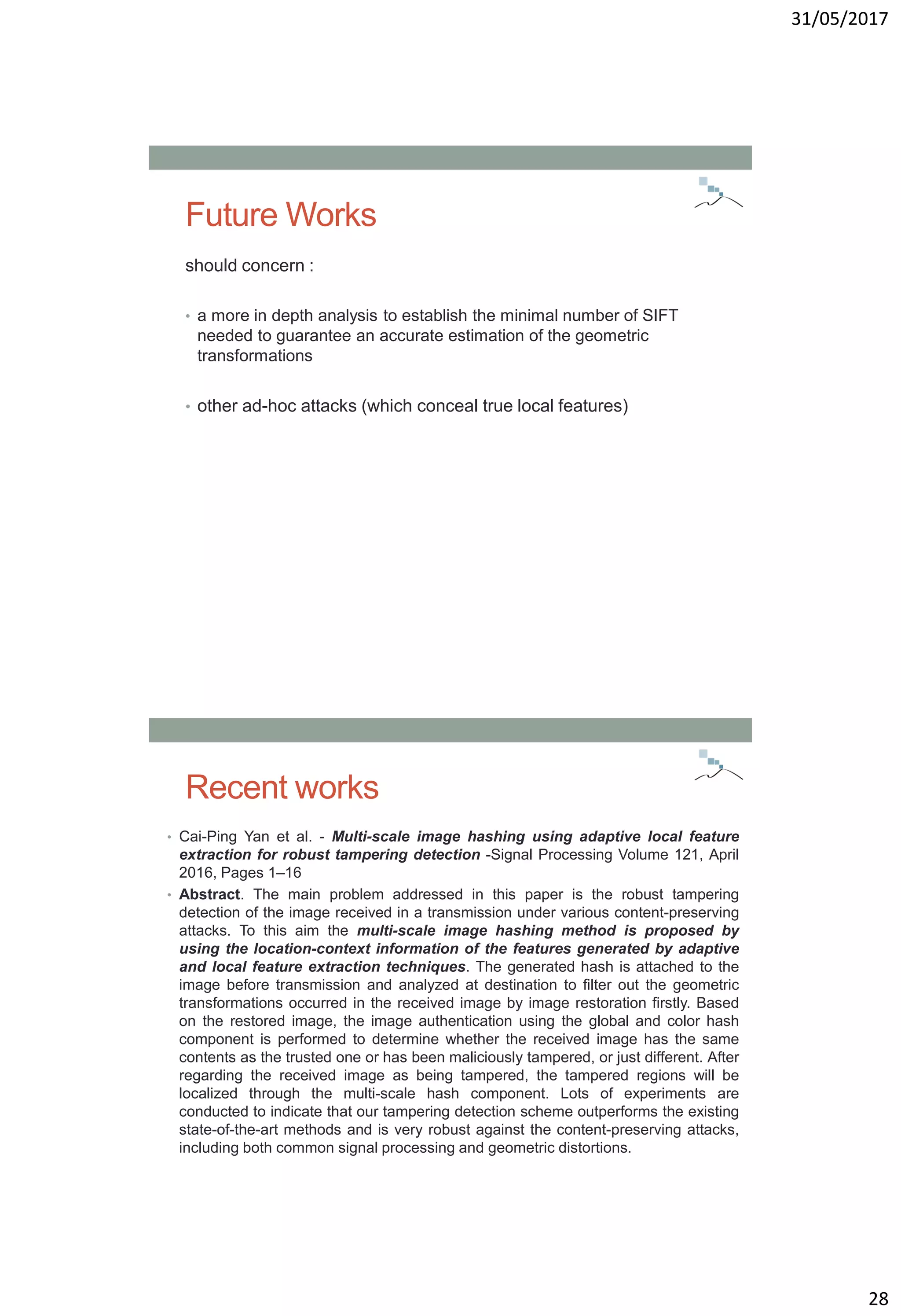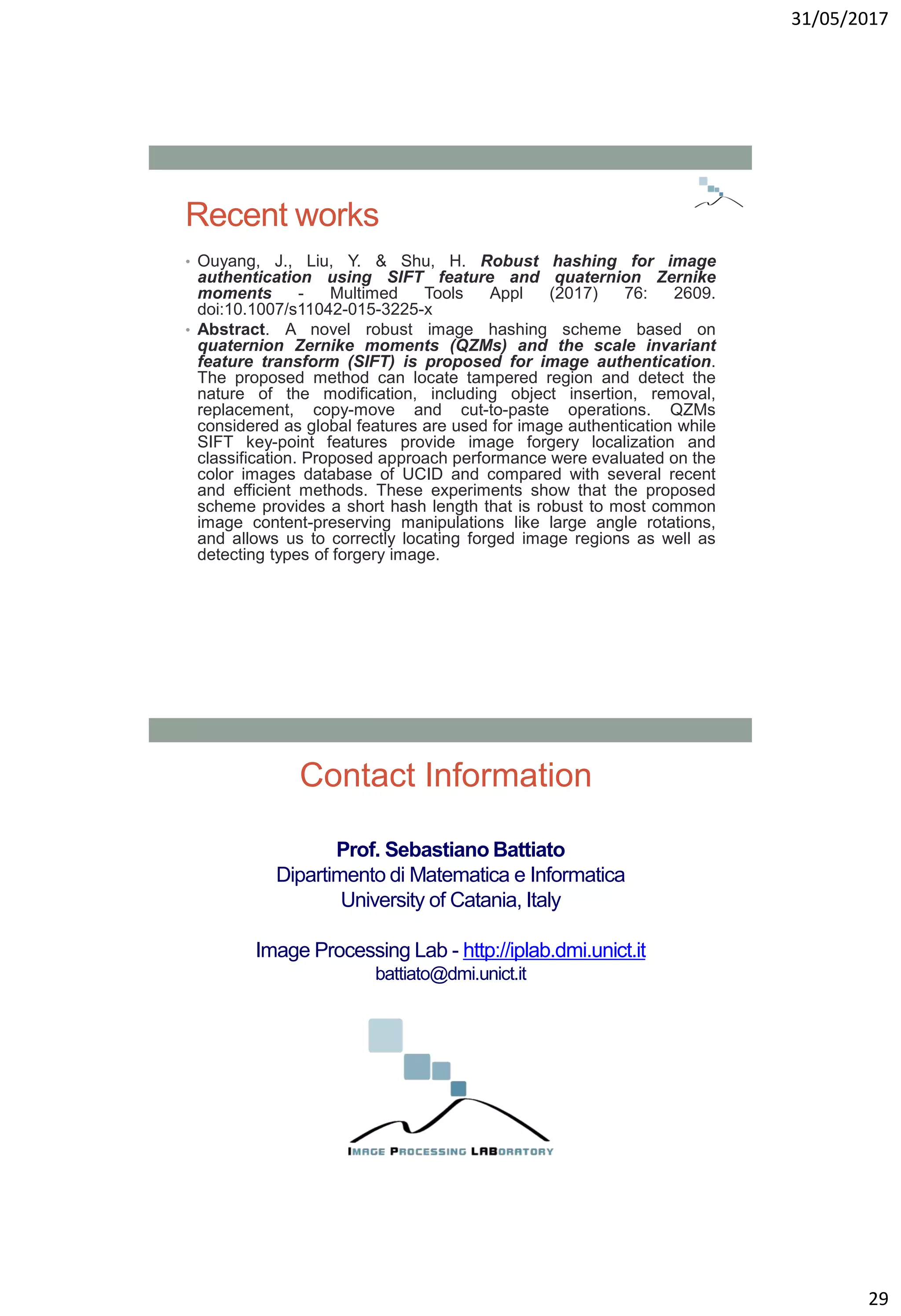The document discusses a proposed approach for robust image alignment aimed at detecting tampering through forensic hashing. It emphasizes the need for effective tampering localization and robust image signatures that can withstand allowed operations while allowing for the identification of manipulations. The authors further assess previous works and present their methods for enhancing alignment and detection accuracy in images subjected to various geometric transformations.
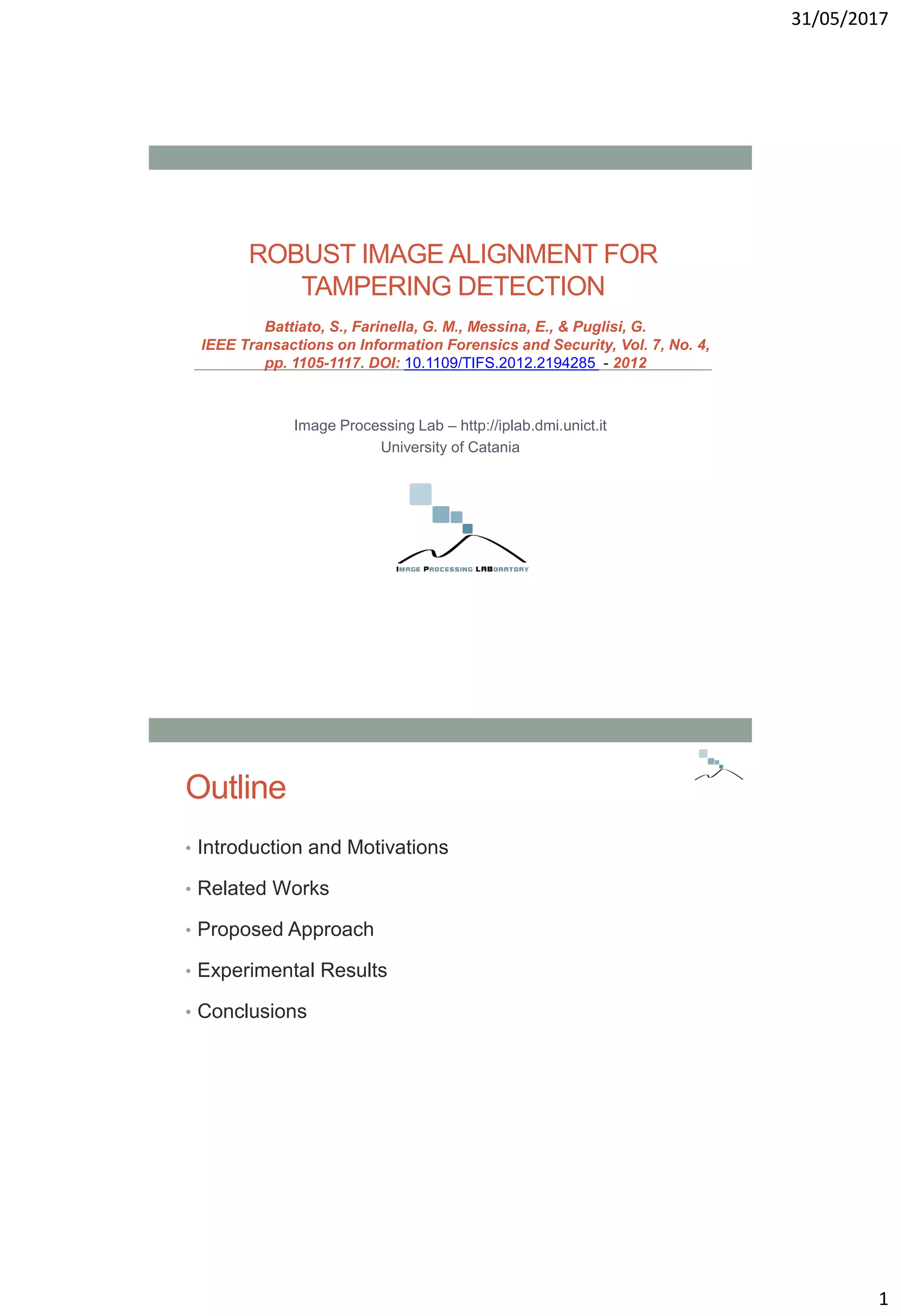
![31/05/2017
2
Introduction and Motivations (1)
• Different episodes make questionable the use of visual
content as evidence material [PT11, HF06].
[PT11] “Photo tampering throughout history,” www.cs.dartmouth.edu/farid/research/digitaltampering/
[HF06] H. Farid, “Digital doctoring: how to tell the real from the fake,” Significance, vol. 3, no. 4, pp.
162–166, 2006.
= +
Introduction and Motivations (2)
Tampering localization is the process of localizing the
regions of the image that have been manipulated for
malicious purposes to change the semantic meaning of
the visual message.
In order to create a more heroic portrait of himself, Benito Mussolini had the
horse handler removed from the original photograph [PT11].
[PT11] “Photo tampering throughout history,” www.cs.dartmouth.edu/farid/research/digitaltampering/
Tampering](https://image.slidesharecdn.com/multimediasecurity-robustimagealignmentfortamperingdetection-170601090506/75/Robust-image-alignment-for-tampering-detection-2-2048.jpg)
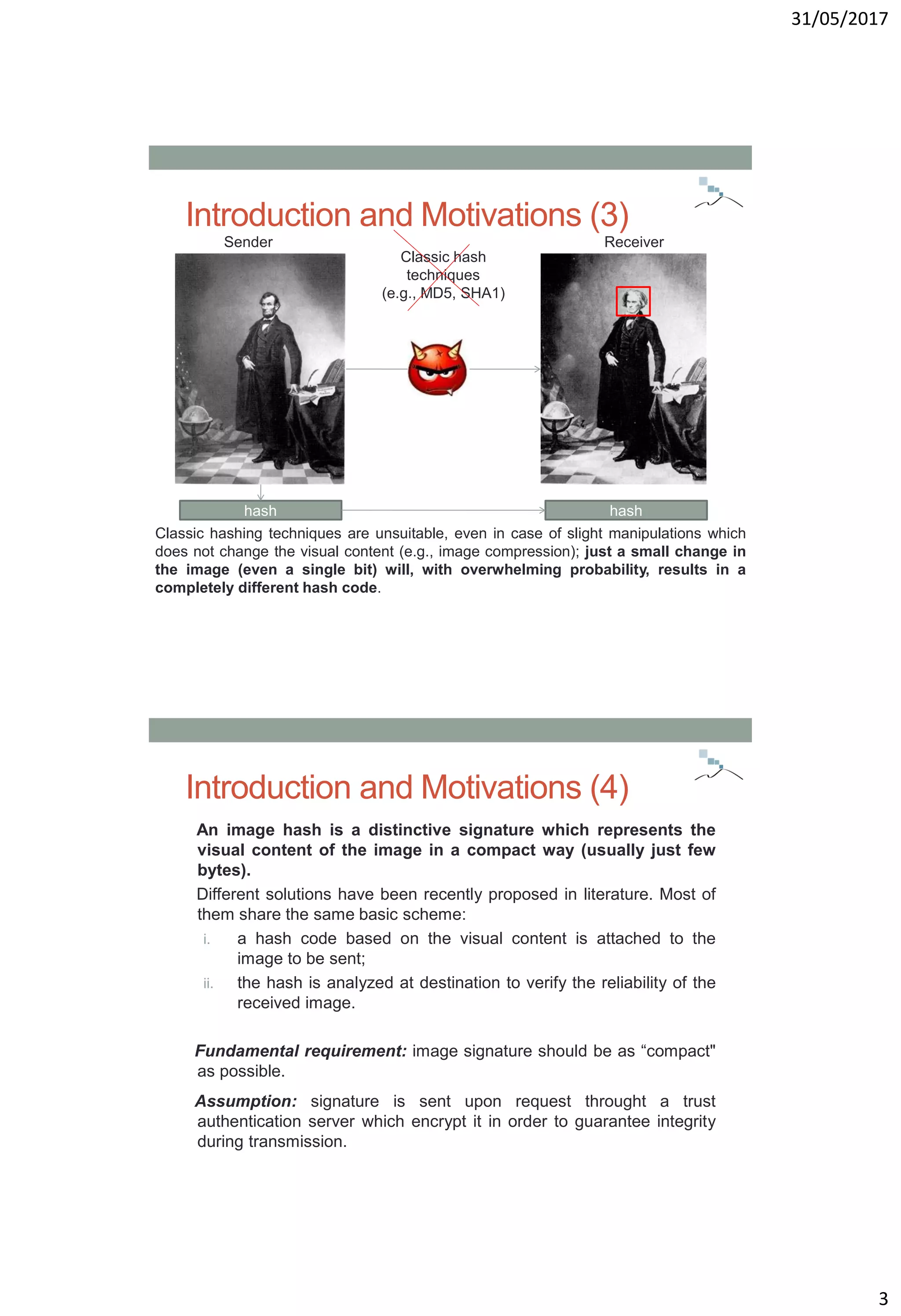
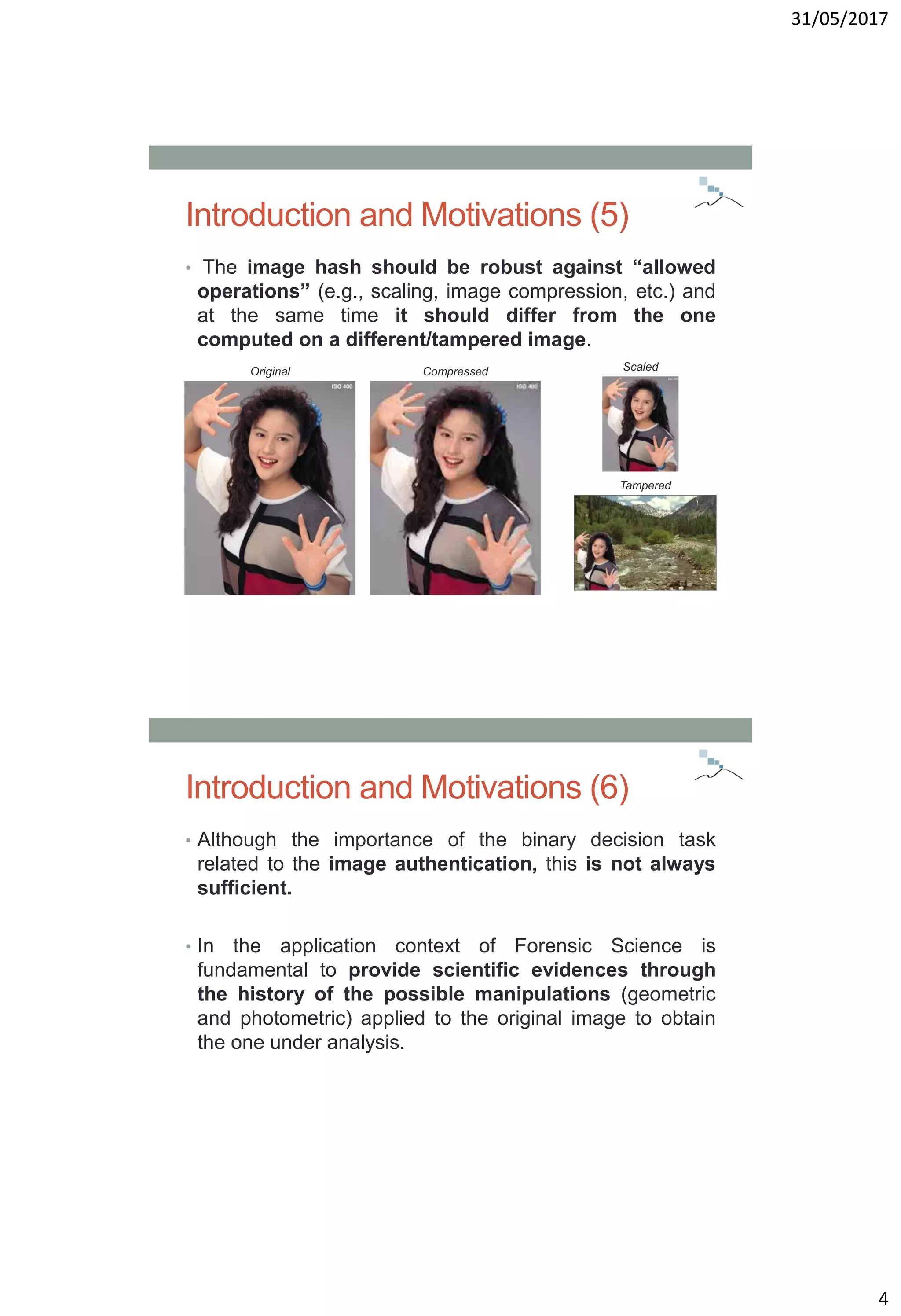
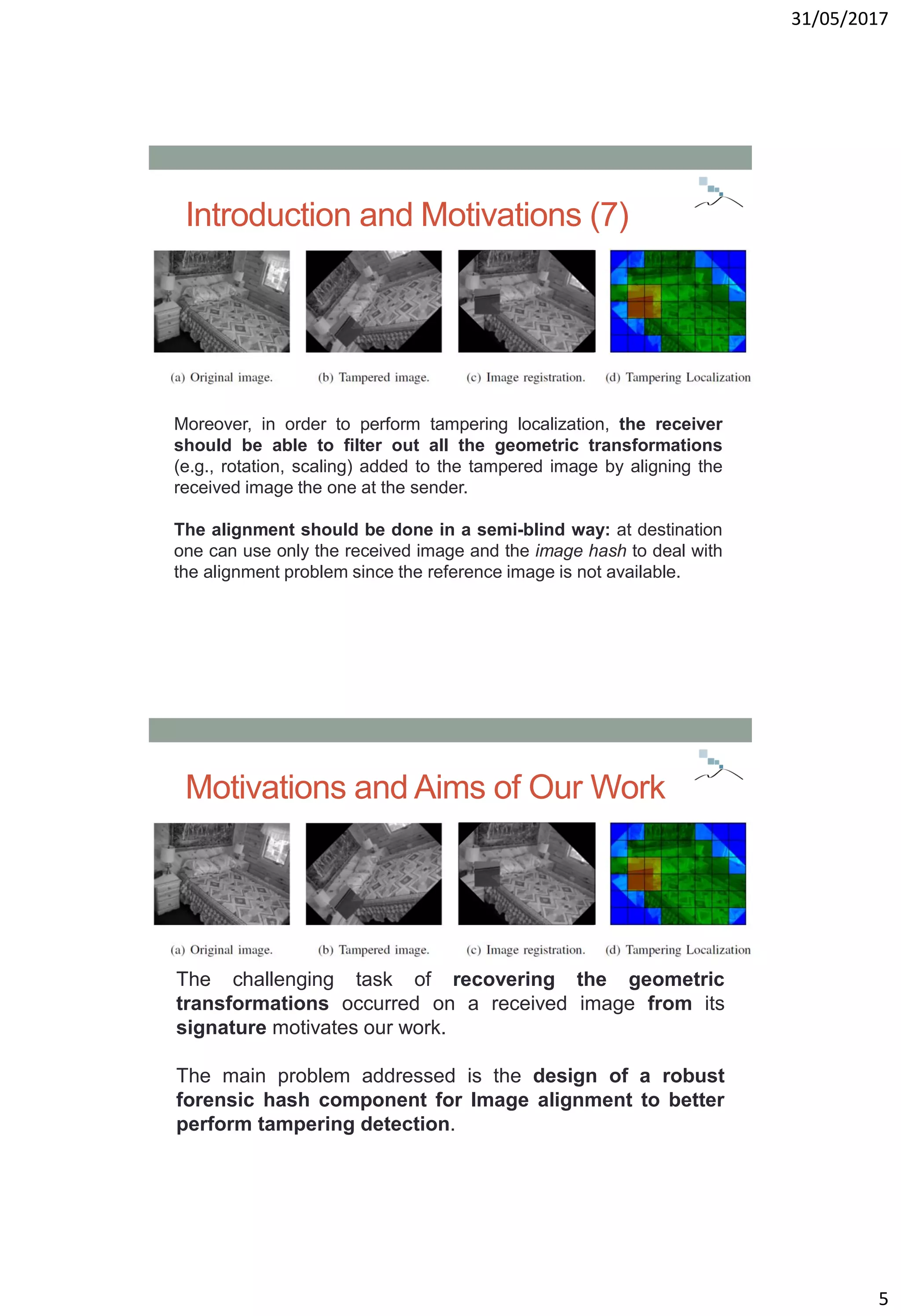
![31/05/2017
6
Destination
Authentication
Algorithms
Related Works: Basic Scheme
Source
Image Hash
(e.g., Alignment
component)
Untrusted Connection
Tampering
Detection
Reliable
Image
Original
Source
Image Received
Image
Trusted
Connection
Related Works (1)
• Fundamental requirement: image signature should be as
“compact" as possible.
Despite different robust alignment techniques have been
proposed by computer vision researchers, these
techniques are unsuitable in the context of forensic
hashing.
• To fit the underlying requirements, authors of [LVW10]
have proposed to exploit information extracted through
Radon transform and scale space theory in order to
estimate the parameters of the geometric
transformations.
[LVW10] W. Lu, A. L. Varna, and M. Wu, “Forensic hash for multimedia information,” in Proceedings of the
IS&T-SPIE Electronic Imaging Symposium - Media Forensics and Security, 2010, vol.7541.](https://image.slidesharecdn.com/multimediasecurity-robustimagealignmentfortamperingdetection-170601090506/75/Robust-image-alignment-for-tampering-detection-6-2048.jpg)
![31/05/2017
7
Related Works (2)
Θ=45
shift along the angle axis=45
Radon
Trasform
Radon
Trasform
become
[LVW10] W. Lu, A. L. Varna, and M. Wu, “Forensic hash for multimedia information,” in Proceedings of the
IS&T-SPIE Electronic Imaging Symposium - Media Forensics and Security, 2010, vol.7541.
Related Works (3)
σ=0.5
σ=0.5
Radon
Trasform
Radon
Trasform
become
[LVW10] W. Lu, A. L. Varna, and M. Wu, “Forensic hash for multimedia information,” in Proceedings of the
IS&T-SPIE Electronic Imaging Symposium - Media Forensics and Security, 2010, vol.7541.](https://image.slidesharecdn.com/multimediasecurity-robustimagealignmentfortamperingdetection-170601090506/75/Robust-image-alignment-for-tampering-detection-7-2048.jpg)
![31/05/2017
8
Related Works (4)
• To make more robust the alignment phase with respect to
manipulations such as cropping and tampering, an image
hash based on robust invariant features has been proposed
in [LW10].
• The above technique extended the idea previously proposed
in [RS07] by employing the Bag of Features (BOF) model to
represent the features to be used as image hash.
• The exploitation of the BOF representation is useful to
reduce the space needed for the image signature, by
maintaining the performances of the alignment component.
[LW10] W. J. Lu and M. Wu, “Multimedia forensic hash based on visual words,” in Proceedings of the IEEE
International Conference on Image Processing, 2010, pp. 989–992.
[RS07] S. Roy and Q. Sun, “Robust hash for detecting and localizing image tampering,” in Proceedings of the
IEEE International Conference on Image Processing, 2007, pp. 117–120.
Related Works (5)
[LW10] W. J. Lu and M. Wu, “Multimedia forensic hash based on visual words,” in Proceedings of the IEEE
International Conference on Image Processing, 2010, pp. 989–992.
22
11
33
44
55
11 nn
nn
11
22
33
44
55
11 nn
nn
hs hr
Ransac (σ)
SIFT points with highest contrast value
+
+
Send
Send
Receive
Receive
Shared Vocabulary
(obtained by clustering
of SIFT points extracted
from a training set)
Match:
same ID and
single occurrence
Ransac (θ)](https://image.slidesharecdn.com/multimediasecurity-robustimagealignmentfortamperingdetection-170601090506/75/Robust-image-alignment-for-tampering-detection-8-2048.jpg)
![31/05/2017
9
Related Works (6)
• In [BS11] a more robust approach based on a cascade of
estimators has been introduced.
• The method in [BS11] is able to better handle the
replicated matchings in order to make a more robust
estimation of the orientation parameter.
• Moreover, the cascade of estimators allows a higher
precision in estimating the scale factor outperforming the
approach in [LW10].
[LW10] W. J. Lu and M. Wu, “Multimedia forensic hash based on visual words,” in Proceedings of the IEEE
International Conference on Image Processing, 2010, pp. 989–992.
[BS11] S. Battiato, G. M. Farinella, E. Messina, and G. Puglisi, “Understanding geometric manipulations of images
through BOVW-based hashing,” in International Workshop on Content Protection & Forensics (CPAF 2011), 2011.
Related Works (7)
[LW10] W. J. Lu and M. Wu, “Multimedia forensic hash based on visual words,” in Proceedings of the IEEE
International Conference on Image Processing, 2010, pp. 989–992.
22
11
33
44
55
11 nn
nn
11
22
33
44
55
11 nn
nn
hs hr
SIFT points with highest contrast value
+
+
Send
Send
Receive
Receive
Match:
same ID and
single occurrence
Ransac (σ)
Ransac (θ)
Shared Vocabulary
(obtained by clustering
of SIFT points extracted
from a training set)](https://image.slidesharecdn.com/multimediasecurity-robustimagealignmentfortamperingdetection-170601090506/75/Robust-image-alignment-for-tampering-detection-9-2048.jpg)
![31/05/2017
10
Related Works (8)
[LW10] W. J. Lu and M. Wu, “Multimedia forensic hash based on visual words,” in Proceedings of the IEEE
International Conference on Image Processing, 2010, pp. 989–992.
[BS11] S. Battiato, G. M. Farinella, E. Messina, and G. Puglisi, “Understanding geometric manipulations of images
through BOVW-based hashing,” in International Workshop on Content Protection & Forensics (CPAF 2011), 2011.
Approach of [BS11]
22
11
33
44
55
11 nn
nn
11
22
33
44
55
11 nn
nn
hs hr
22
11
33
44
55
11 nn
nn
11
22
33
44
55
11 nn
nn
hs hr
Approach of [LW10]
Ransac (σ)
Ransac (θ)
Learned from previous works…
• The exploitation of the BOF representation is
useful to reduce the space needed for the image
signature, by maintaining the performances of the
alignment component.
• Handle replicated matchings help to make more
robust the parameters estimation phase
(especially for rotation angle estimation).
• Cascade approach (filtering) help to make more
robust the parameters estimation phase
(especially for the scale factor estimation).
22
11
33
44
55
11 nn
nn
11
22
33
44
55
11 nn
nn ](https://image.slidesharecdn.com/multimediasecurity-robustimagealignmentfortamperingdetection-170601090506/75/Robust-image-alignment-for-tampering-detection-10-2048.jpg)
![31/05/2017
11
What we have done more…
Feature selection problem
Transformation model (e.g.,
we wish to estimate traslation
too)
Check the robustness on a
bigger and challenging dataset
by considering different image
transformation
Consider realistic tampering
samples
ID
ID
2
1
7.0
30
Ty
Tx
Sender Receiver
Features Selection:
Ordering by contrast values
SIFT features extraction
SIFT ordering by contrast values
and selection of top n SIFT
SIFT
[θ,λ,(x,y)]
label (id)
1
2
Associate id value of the
closest prototype belonging
to the shared codebook
3
222 yx
333 yx
444 yx
555 yx
111 yx
111 nnn yx
nnn yx
The signature is
composed of all the
quadruple [id,θ,x,y]
associated to the
selected SIFT features
4
h
Signature
Generation
Process](https://image.slidesharecdn.com/multimediasecurity-robustimagealignmentfortamperingdetection-170601090506/75/Robust-image-alignment-for-tampering-detection-11-2048.jpg)
![31/05/2017
12
Features Selection:
Spatial Distribution and Ordering by Contrast Values
SIFT features extraction
cluster-based SIFT
ordering by contrast
values and selection
of top one for each
cluster SIFT
[θ,λ,(x,y)]
label (id)
Associate id value of the
closest prototype belonging
to the shared codebook
The signature is
composed of all the
quadruple [id,θ,x,y]
associated to the
selected SIFT features
2
3
5
h
Signature
Generation
Process
Spatial
Clustering
4
1
222 yx
333 yx
444 yx
555 yx
111 yx
111 nnn yx
nnn yx
Previous Approaches Proposed solution
Features Selection: Example
Original Image Pattern
Different matches are preservedAll are wrong matches
Sender Receiver Sender Receiver
SpatialDistributionand
OrderingbyContrastValues
OrderingbyContrastValues](https://image.slidesharecdn.com/multimediasecurity-robustimagealignmentfortamperingdetection-170601090506/75/Robust-image-alignment-for-tampering-detection-12-2048.jpg)
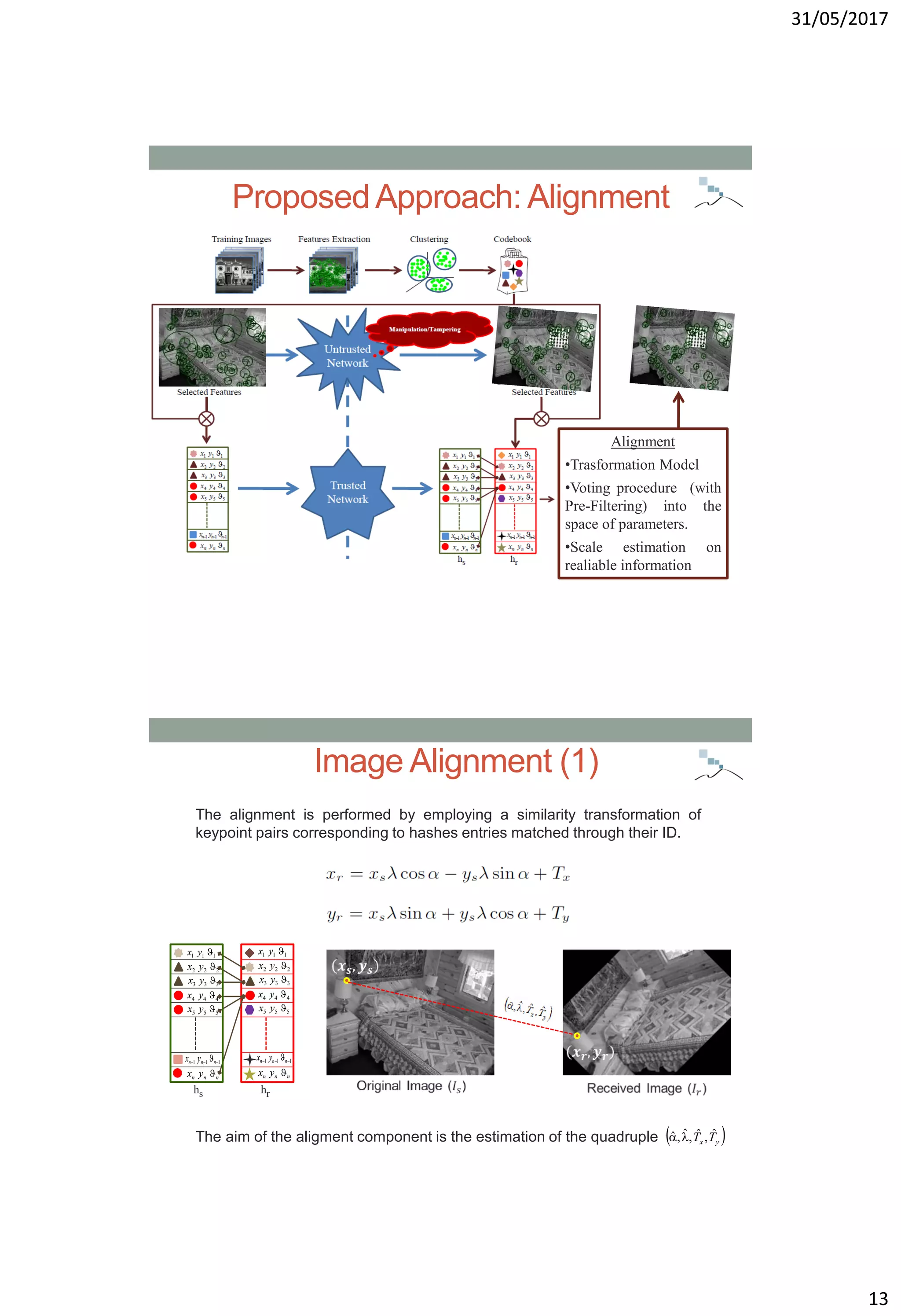
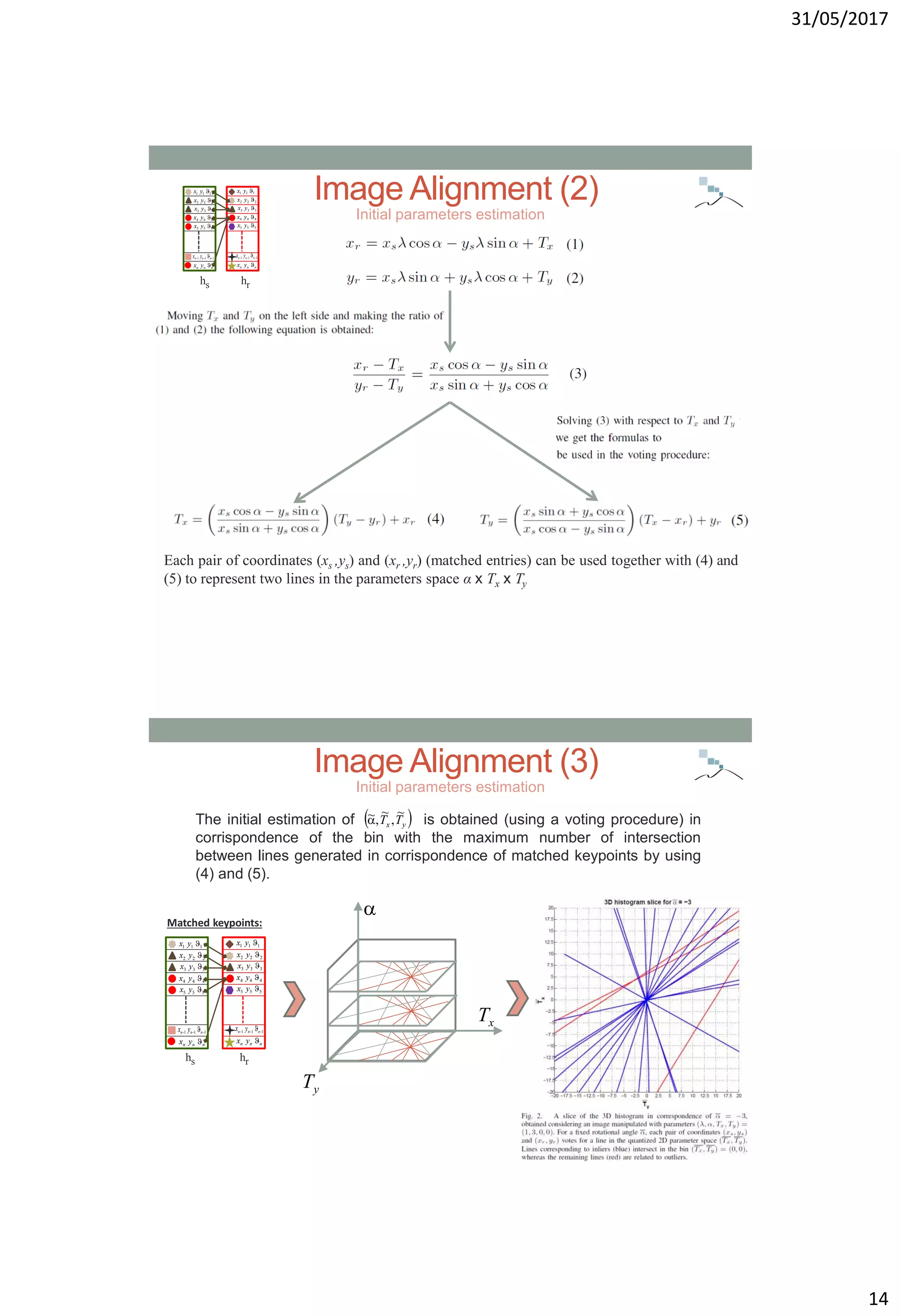
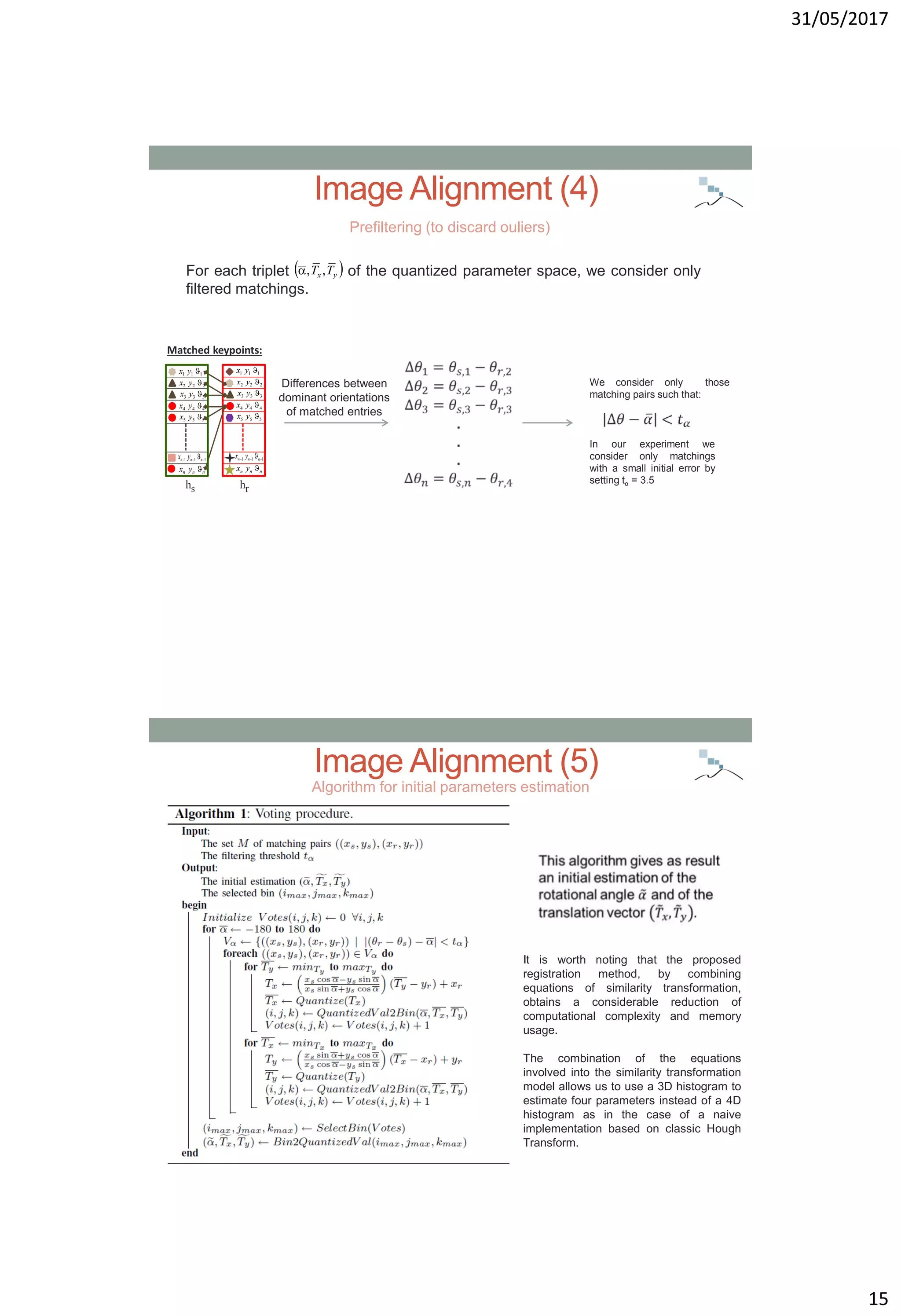
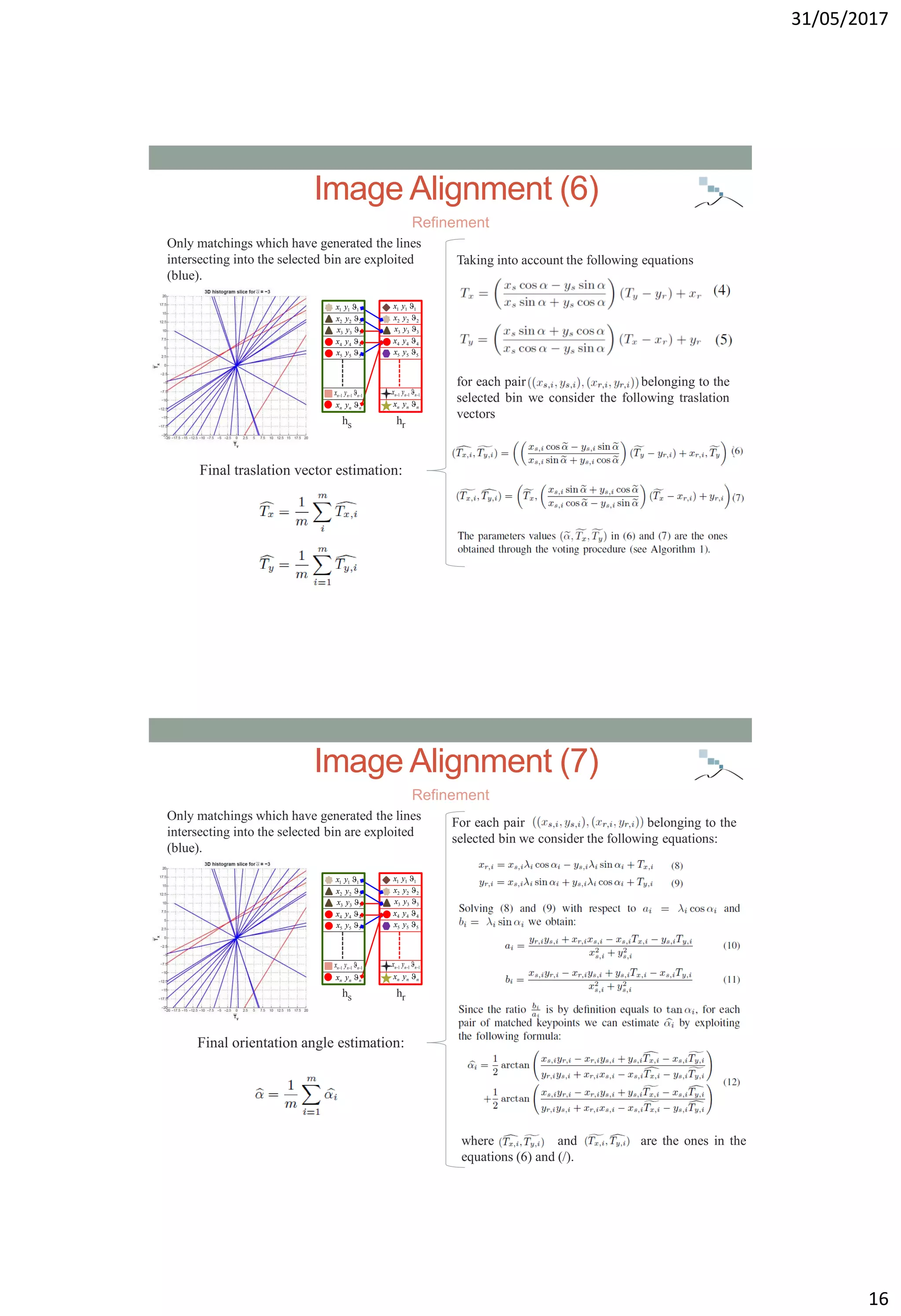

![31/05/2017
18
Experimental Dataset (1)
In order to cope with scene variability the tests have been performed
considering a subset of the fifteen scene category benchmark dataset
[LSP06] and the dataset DBForgery 1.0 [BM09].
[LSP06] S. Lazebnik, C. Schmid, and J. Ponce, “Beyond bags of features: Spatial pyramid matching for recognizing
natural scene categories,” in Proceedings of the IEEE Conference on Computer Vision and Pattern Recognition, 2006,
pp. 2169–2178.
[BM09] S. Battiato, G. Messina "Digital Forgery Estimation into DCT Domain - A Critical Analysis", ACM Multimedia
2009, Multimedia in Forensics (MiFor'09), October 2009, Beijing, China.
Ten images have been randomly
sampled from each scene category
(average size: 244x272 pixels).
29 different images tampered with
different parameter settings
(average size: 470x500 pixels)
+
• The training set used in the experiments is built through a
random selection of 179 images from the previous
mentioned datasets.
• The test set consists of 21330 images generated through the
application of different manipulations on the training images.
Experimental Dataset (2)
Operations Parameters
Rotation (α) 3, 5, 10, 30, 45 degrees
Scaling (σ) factor = 0.5, 0.7, 0.9, 1.2, 1.5
Orizontal Traslation (Tx) 5, 10, 20 pixels
Vertical Traslation (Ty) 5, 10, 20 pixels
Cropping 19%, 28%, 36%, of entire image
Tampering block size 50x50
Malicious Tampering block size 50x50
Linear Photometric Transformation (a*I+b)
a = 0.90, 0.95, 1, 1.05, 1.10
b = -10, -5, 0, 5, 10
Compression JPEG Q=10
Seam Carving 10%, 20%, 30%
Realistic Tampering [BM09]
Various combinations of above operations](https://image.slidesharecdn.com/multimediasecurity-robustimagealignmentfortamperingdetection-170601090506/75/Robust-image-alignment-for-tampering-detection-18-2048.jpg)
![31/05/2017
19
Image Alignment – Results (1)
Proposed approach
Number of SIFT 15 30 45 60
Unmatched Images 5.18% 1.90% 1.12% 0.83%
Spatial Clustering without with without with without with without with
Mean Error α 1.3826 1.9911 0.8986 0.8627 0.6661 0.6052 0.5658 0.4518
Mean Error σ 0.0462 0.0593 0.0306 0.0302 0.0241 0.0200 0.0208 0.0164
Mean Error Tx 2.7672 3.3191 1.8621 1.9504 1.5664 1.5626 1.4562 1.4227
Mean Error Ty 2.6650 3.2428 1.9409 2.0750 1.7009 1.7278 1.6008 1.5944
Image Alignment – Results (2)
[LW10] W. J. Lu and M. Wu, “Multimedia forensic hash based on visual words,” in Proceedings of the IEEE
International Conference on Image Processing, 2010, pp. 989–992.
[BS11] S. Battiato, G. M. Farinella, E. Messina, and G. Puglisi, “Understanding geometric manipulations of images
through BOVW-based hashing,” in International Workshop on Content Protection & Forensics (CPAF 2011), 2011.
Unmatched Images
Number of SIFT 15 30 45 60
Lu et al. [LW10] 7.87% 2.77% 1.52% 1.16%
Battiato et al. [BS11] 0.86% 0.48% 0.25% 0.08%
Proposed approach without spatial clustering 3.00% 1.35% 0.87% 0.73%
Proposed approach with spatial clustering 2.53% 0.64% 0.18% 0.10%](https://image.slidesharecdn.com/multimediasecurity-robustimagealignmentfortamperingdetection-170601090506/75/Robust-image-alignment-for-tampering-detection-19-2048.jpg)
![31/05/2017
20
Image Alignment – Results (3)
[LW10] W. J. Lu and M. Wu, “Multimedia forensic hash based on visual words,” in Proceedings of the IEEE
International Conference on Image Processing, 2010, pp. 989–992.
[BS11] S. Battiato, G. M. Farinella, E. Messina, and G. Puglisi, “Understanding geometric manipulations of images
through BOVW-based hashing,” in International Workshop on Content Protection & Forensics (CPAF 2011), 2011.
Mean Error α
Number of SIFT 15 30 45 60
Unmatched Images 10.99% 3.85% 2.02% 1.56%
Lu et al. [LW10] 7.3311 7.9970 7.8600 7.4125
Battiato et al. [BS11] 3.4372 2.4810 2.4718 1.9581
Proposed approach without spatial clustering 1.1591 0.8206 0.5485 0.4634
Proposed approach with spatial clustering 1.7933 0.8288 0.5735 0.4318
Mean Error σ
Number of SIFT 15 30 45 60
Unmatched Images 10.99% 3.85% 2.02% 1.56%
Lu et al. [LW10] 0.0619 0.0680 0.0625 0.0592
Battiato et al. [BS11] 0.0281 0.0229 0.0197 0.0179
Proposed approach without spatial clustering 0.0388 0.0281 0.0214 0.0183
Proposed approach with spatial clustering 0.0541 0.0287 0.0195 0.0161
Image Alignment – Results (5)
[LW10] W. J. Lu and M. Wu, “Multimedia forensic hash based on visual words,” in Proceedings of the IEEE
International Conference on Image Processing, 2010, pp. 989–992.
[BS11] S. Battiato, G. M. Farinella, E. Messina, and G. Puglisi, “Understanding geometric manipulations of images
through BOVW-based hashing,” in International Workshop on Content Protection & Forensics (CPAF 2011), 2011.](https://image.slidesharecdn.com/multimediasecurity-robustimagealignmentfortamperingdetection-170601090506/75/Robust-image-alignment-for-tampering-detection-20-2048.jpg)
![31/05/2017
21
Image Alignment – Results (6)
[LW10] W. J. Lu and M. Wu, “Multimedia forensic hash based on visual words,” in Proceedings of the IEEE
International Conference on Image Processing, 2010, pp. 989–992.
[BS11] S. Battiato, G. M. Farinella, E. Messina, and G. Puglisi, “Understanding geometric manipulations of images
through BOVW-based hashing,” in International Workshop on Content Protection & Forensics (CPAF 2011), 2011.
Malicious Manipulation
Unmatched Images
Number of SIFT 15 30 45 60
Lu et al. [LW10] 90.50% 87.71% 81.01% 73.74%
Battiato et al. [BS11] 68.72% 54.19% 29.61% 9.50%
Proposed approach without spatial clustering 87.15% 86.03% 74.86% 64.25%
Proposed approach with spatial clustering 0% 0% 0% 0%
Mean Error α
Number of SIFT 15 30 45 60
Lu et al. [LW10] 85.6844 79.9884 88.4555 97.4700
Battiato et al. [BS11] 86.9447 92.0451 92.5144 91.8478
Proposed approach without spatial clustering 35.6087 33.6800 42.5111 38.5156
Proposed approach with spatial clustering 1.2458 0.0000 0.0000 0.0000
Mean Error σ
Number of SIFT 15 30 45 60
Lu et al. [LW10] 0.2868 0.2934 0.2920 0.3482
Battiato et al. [BS11] 0.3141 0.3453 0.3505 0.3493
Proposed approach without spatial clustering 0.8249 0.7891 0.9284 0.7706
Proposed approach with spatial clustering 0.0193 0.0005 0.0002 0.0006
Unmatched Images
45 60
20.67% 21.79%
1.68% 1.12%
14.53% 13.97%
0.00% 0.00%
Mean Error α
45 60
14.2848 13.4975
34.3832 36.8093
7.0392 9.6364
0.0000 0.0000
Mean Error σ
45 60
0.0538 0.0564
0.1288 0.1608
0.1141 0.1815
0.0003 0.0004
patch size 50x50 patch size 25x25
Image Alignment – Results (7)
Malicious Manipulation (50x50)
[LW10] W. J. Lu and M. Wu, “Multimedia forensic hash based on visual words,” in Proceedings of the IEEE
International Conference on Image Processing, 2010, pp. 989–992.
[BS11] S. Battiato, G. M. Farinella, E. Messina, and G. Puglisi, “Understanding geometric manipulations of images
through BOVW-based hashing,” in International Workshop on Content Protection & Forensics (CPAF 2011), 2011.
Number of SIFT 45 60
Unmatched Images 92.74% 89.39%
Mean Error α σ α σ
Lu et al. [LW11] 81.1994 0.2750 88.2215 0.3126
Battiato et al. [BS10] 96.5480 0.4163 88.3088 0.3058
Proposed approach without spatial clustering 32.3846 0.7285 34.9474 0.6213
Proposed approach with spatial clustering 0.0000 0.0001 0.0000 0.0009](https://image.slidesharecdn.com/multimediasecurity-robustimagealignmentfortamperingdetection-170601090506/75/Robust-image-alignment-for-tampering-detection-21-2048.jpg)
![31/05/2017
22
Realistic Tampering (DBForgery1.0) [BM09]
Image Alignment – Results (8)
[BM09] S. Battiato, G. Messina "Digital Forgery Estimation into DCT Domain - A Critical Analysis", ACM
Multimedia 2009, Multimedia in Forensics (MiFor'09), October 2009, Beijing, China.
Proposed approach without sp
Proposed approach with spa
Proposed approach without sp
Proposed approach with spa
Proposed approach without sp
Proposed approach with spa
Proposed approach without sp
Proposed approach with spa
Number of SIF
UnmatchedNumber of SIFT 15 30 45 60
Unmatched 3.45% 0.00% 0.00% 0.00%
Spatial Clustering without with without with without with without with
Mean Error α 0.1071 0.0000 0.0690 0.0000 0.0000 0.0000 0.0000 0.0000
Mean Error σ 0.0065 0.0002 0.0014 0.0002 0.0006 0.0006 0.0003 0.0003
Mean Error Tx 0.5675 0.0171 0.1699 0.0104 0.0106 0.0140 0.0092 0.0130
Mean Error Ty 0.3718 0.0270 0.0283 0.0219 0.0178 0.0172 0.0144 0.0138
Image Alignment – Results (9)
Cropping
Number of SIFT 15 30 45 60
Unmatched 2.05% 0.74% 0.00% 0.00%
Spatial Clustering without with without with without with without with
Mean Error α 1.5494 1.5399 0.2758 0.2720 0.1750 0.1266 0.1695 0.0782
Mean Error σ 0.0416 0.0427 0.0143 0.0089 0.0078 0.0064 0.0088 0.0061
Mean Error Tx 2.3241 2.1522 0.6974 0.6862 0.5512 0.4864 0.5444 0.4527
Mean Error Ty 1.9857 1.9840 0.7036 0.6820 0.5474 0.4773 0.5158 0.4660](https://image.slidesharecdn.com/multimediasecurity-robustimagealignmentfortamperingdetection-170601090506/75/Robust-image-alignment-for-tampering-detection-22-2048.jpg)
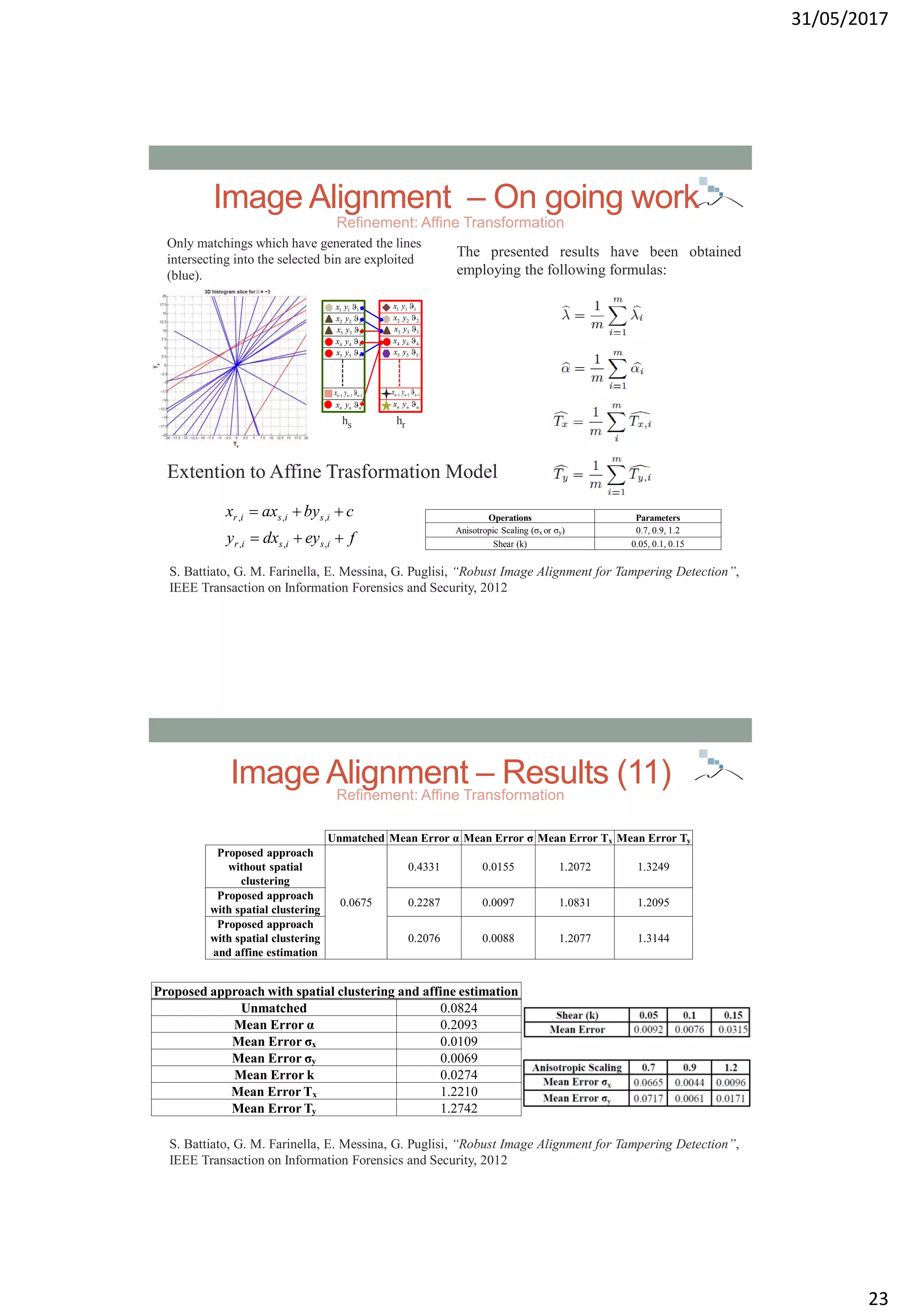
![31/05/2017
24
Alignment - Complexity Comparison
[LW10] W. J. Lu and M. Wu, “Multimedia forensic hash based on visual words,” in Proceedings of the IEEE
International Conference on Image Processing, 2010, pp. 989–992.
[BS11] S. Battiato, G. M. Farinella, E. Messina, and G. Puglisi, “Understanding geometric manipulations of images
through BOVW-based hashing,” in International Workshop on Content Protection & Forensics (CPAF 2011), 2011.
ProposedApproach: Tampering
Tampering Detection
Hash for
tampering
Hash for
tampering
=
?
Alignment
•Trasformation Model
•Voting procedure (with
Pre-Filtering) into the
space of parameters.
•Scale estimation on
realiable information](https://image.slidesharecdn.com/multimediasecurity-robustimagealignmentfortamperingdetection-170601090506/75/Robust-image-alignment-for-tampering-detection-24-2048.jpg)
![31/05/2017
25
Tampering Detection (1)
Representation of each block is based on histogram of oriented gradients (HOG)
magnitudo
orientation
Finally, the histogram is normalized and quantized.
(ϑ1,ρ1)
(ϑ2,ρ2)
:
:
(ϑL,ρL)
4 bins
For each pixel of the block the
magnitudo ρ and the
orientation θ are computed
Create the gradient
image and divide it into
blocks of 32x32 pixels
Each pixel of the block
votes for a bin using its
magnitude
Tampering Detection (2)
Each block representation is part of the image signature, so it has to be as small as
possible. We compared two different solutions:
Uniform quantization Non-uniform quantization
Each bin is quantized using a
fixed number of bits. In our
tests, we used 3 bits. So, 12
bits are required to encode a
single histogram.
Sequence of 12 bits
3bits
For each image with N
blocks, 12*N bits are needed
to encode the hash.
It uses a precomputed shared vocabulary of
histograms of oriented gradients, making a
clustering (through k-means) considering all the
histogram of gradients extracted from the whole scene
category dataset.
. . .(1) (2) (3) (k)
The sequence of ids is the image hash representation.
In this case the histogram centroids are not quantized.
Each block is hence associated to an ID
corresponding to the closed centroid.
[id1,id2,…idk]](https://image.slidesharecdn.com/multimediasecurity-robustimagealignmentfortamperingdetection-170601090506/75/Robust-image-alignment-for-tampering-detection-25-2048.jpg)
![31/05/2017
26
(1)
Tampering Detection (3)
Similarity
Tampering Detection – Results (1)
[LW10] W. J. Lu and M. Wu, “Multimedia forensic hash based on visual words,” in Proceedings of the IEEE
International Conference on Image Processing, 2010, pp. 989–992.
[BS11] S. Battiato, G. M. Farinella, E. Messina, and G. Puglisi, “Understanding geometric manipulations of images
through BOVW-based hashing,” in International Workshop on Content Protection & Forensics (CPAF 2011), 2011.](https://image.slidesharecdn.com/multimediasecurity-robustimagealignmentfortamperingdetection-170601090506/75/Robust-image-alignment-for-tampering-detection-26-2048.jpg)
